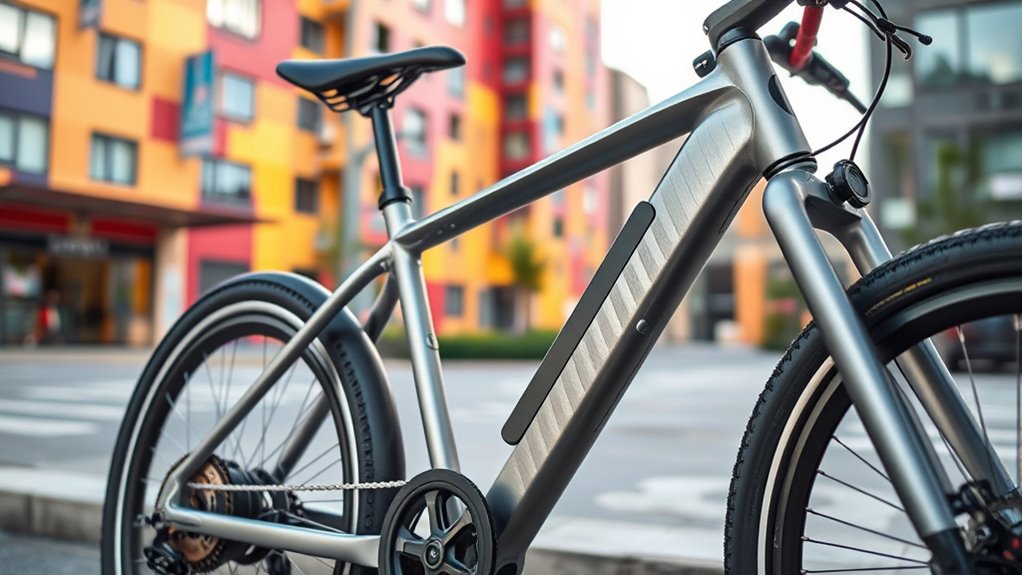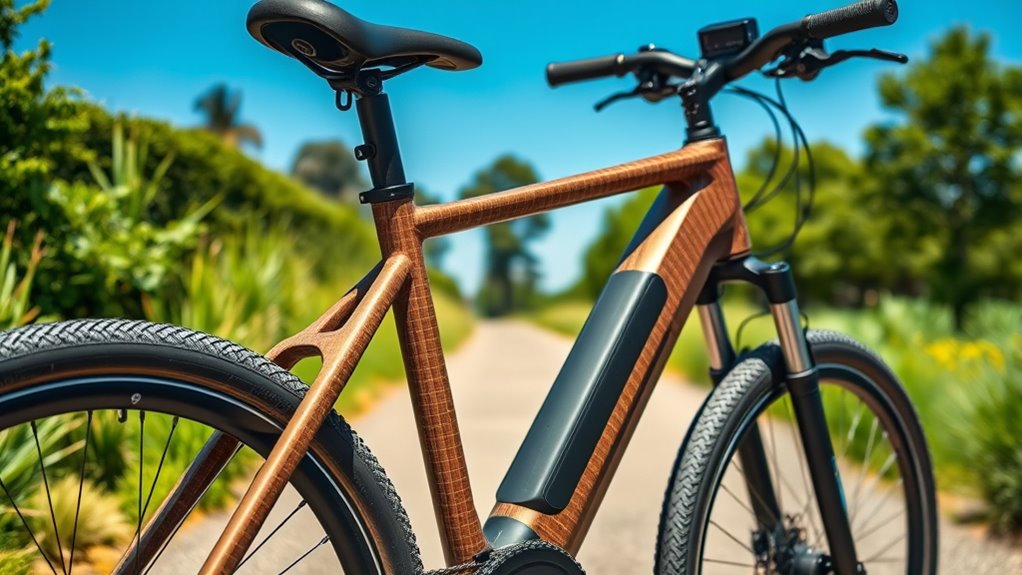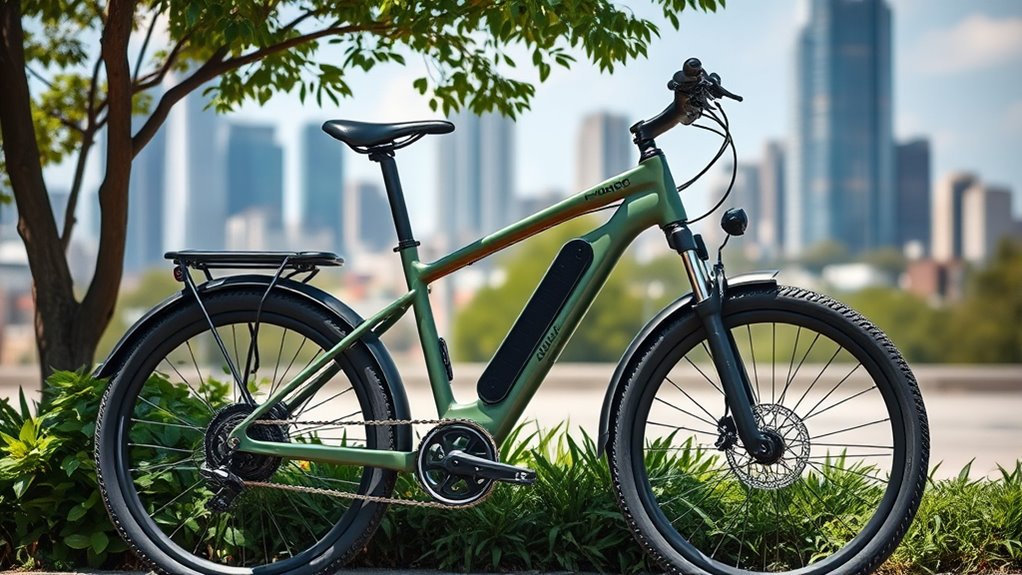Modern e-bikes are increasingly made with sustainable materials like biodegradable plastics for components, recycled metals for frames, eco-friendly paints and coatings, natural fiber composites for lightweight structures, and eco-conscious batteries. These innovations help reduce environmental impact while maintaining durability and performance. If you want to explore how these materials are shaping the future of eco-friendly transportation, there’s plenty more detail to uncover behind the scenes.
Key Takeaways
- Use of biodegradable and compostable plastics in e-bike parts reduces environmental impact and enhances eco-friendliness.
- Recycled metals like aluminum and steel are employed in frames, promoting resource conservation and lightweight, durable construction.
- Eco-friendly paints and coatings improve durability while minimizing toxic emissions and chemical hazards during manufacturing.
- Natural fiber composites such as hemp or flax offer lightweight, sustainable alternatives to traditional materials for e-bike frames.
- Incorporation of sustainable battery materials, including recycled components and eco-friendly chemistries, supports circular economy principles.
Biodegradable and Compostable Plastics in E-Bike Components

Biodegradable and compostable plastics are increasingly being integrated into e-bike components as sustainable alternatives to traditional plastics. These materials break down naturally, reducing environmental impact and waste accumulation. Biodegradable plastics are designed to decompose through biological activity, turning into natural elements over time. Compostable plastics go a step further, breaking down into compost in specific conditions, enriching the soil. Using these plastics in parts like casings, grips, and interior components helps lower the carbon footprint of e-bikes. They offer durability while maintaining eco-friendliness, making them a smart choice for manufacturers committed to sustainability. As technology advances, the availability of biodegradable and compostable plastics improves, allowing you to enjoy the benefits of eco-conscious riding without sacrificing quality or performance. High-quality materials are essential to ensure these sustainable plastics meet the durability standards required for e-bike components.
Recycled Metals and Alloys for Frame Manufacturing

Have you considered how recycled metals and alloys are transforming e-bike frame manufacturing? By focusing on metal recovery, manufacturers can reuse materials, reducing environmental impact. Recycled aluminum and steel are popular choices due to their high strength-to-weight ratio and durability. When selecting alloys, you should consider factors like corrosion resistance and weight, which influence performance and longevity. Here are three key points to keep in mind:
- Metal recovery minimizes waste and conserves resources.
- Alloy selection impacts the bike’s weight, strength, and sustainability.
- Recycled metals often meet industry standards, ensuring safety and reliability.
- The use of sustainable sourcing in materials further enhances the environmental benefits of recycled metals.
Using recycled metals and alloys not only supports sustainability but also helps create lightweight, durable frames perfect for modern e-bikes.
Eco-Friendly Paints and Coatings for Enhanced Durability

Building on the sustainability achieved through recycled metals, choosing eco-friendly paints and coatings further enhances your e-bike’s environmental profile. Eco friendly paints reduce harmful emissions and avoid toxic chemicals, making your ride safer for both you and the planet. These paints are formulated with renewable or low-VOC ingredients, supporting greener manufacturing processes. Durable coatings ensure your e-bike withstands weather, abrasions, and daily use, extending its lifespan. By selecting eco-friendly paints with strong protective qualities, you combine environmental responsibility with long-term durability. This not only preserves your bike’s appearance but also minimizes maintenance and replacement needs. Incorporating color retention properties in your coatings can help maintain the vibrant look of your e-bike over time. Ultimately, integrating eco-friendly paints and durable coatings aligns your commitment to sustainability with the practical benefits of enhanced protection and longevity.
Innovative Natural Fiber Composites for Lightweight Frames

Innovative natural fiber composites are transforming the design of lightweight e-bike frames by offering a sustainable alternative to traditional materials. Natural fiber integration allows you to reduce environmental impact while maintaining strength and durability. These composites leverage composite material innovation, combining fibers like hemp, flax, or jute with bio-based resins for enhanced performance. Additionally, the adoption of fraud detection techniques in the manufacturing process ensures the integrity and authenticity of the materials used, further supporting sustainability goals.
The Role of Sustainable Battery Materials in E-Bike Design

As e-bike designs prioritize sustainability through lightweight natural fiber composites, attention shifts toward the batteries that power these vehicles. Sustainable battery materials play a crucial role in reducing environmental impact. You can improve the lifecycle of batteries by prioritizing battery recycling, which minimizes waste and recovers valuable materials. Incorporating renewable energy into manufacturing processes further enhances sustainability, ensuring that the energy used to produce batteries comes from clean sources. Using eco-friendly materials like lithium iron phosphate or alternative chemistries reduces reliance on scarce resources and limits toxic waste. Your focus on sustainable battery development not only extends the lifespan of e-bikes but also supports a circular economy, making e-bikes a greener transportation option for the future. Implementing beginners guides on proper disposal and recycling methods can further promote responsible usage and environmental stewardship.
Frequently Asked Questions
How Do Sustainable Materials Impact E-Bike Performance and Longevity?
Sustainable materials can boost your e-bike’s performance and longevity by improving material durability, so parts last longer and resist wear. They also enable weight reduction, making your ride more efficient and easier to handle. You’ll notice better acceleration and battery life with lighter components. Plus, choosing eco-friendly materials helps protect the environment, so you ride confidently knowing your e-bike is both durable and sustainable.
Are Eco-Friendly Materials Cost-Effective Compared to Traditional Options?
Thinking of eco-friendly materials as seeds for a greener future, you’ll find they can be cost-effective over time. While initial costs might be higher, recycling initiatives and material recycling reduce waste and lower expenses. These sustainable options often save money through durability and lower maintenance. So, investing in eco-friendly materials isn’t just good for the planet—it’s smart financially, making them a wise choice compared to traditional options.
What Challenges Exist in Sourcing Sustainable Materials for Mass Production?
When sourcing sustainable materials for mass production, you face supply chain complexities that can slow down or increase costs. Finding reliable suppliers who provide durable, eco-friendly materials is challenging, and ensuring these materials meet quality standards takes effort. You also need to balance material durability with sustainability, which often requires additional research and testing. These hurdles can make it harder to efficiently incorporate sustainable materials into large-scale manufacturing processes.
How Do Consumers Perceive E-Bikes Made With Eco-Friendly Components?
You might think eco-friendly e-bikes are just a marketing ploy, but consumers increasingly trust brands prioritizing sustainability. They perceive e-bikes made with eco-friendly components as more trustworthy and aligned with environmental values. This boost in consumer trust enhances brand reputation, making eco-conscious choices more appealing. When you choose an e-bike with sustainable materials, you’re not only supporting greener transportation but also reinforcing brands committed to responsible practices.
What Future Innovations Are Anticipated in Sustainable E-Bike Materials?
You’re curious about future innovations in e-bike materials. Experts anticipate the integration of biodegradable composites, which will reduce environmental impact, and recycled aluminum alloys, ensuring durability while promoting sustainability. These advancements will likely make e-bikes lighter, more eco-friendly, and cost-effective. As a consumer, you’ll benefit from bikes that perform well and align with your values, helping you contribute to a greener planet while enjoying enhanced riding experiences.
Conclusion
By choosing e-bikes with sustainable materials, you’re helping to reduce environmental impact and promote greener transportation. From biodegradable plastics to natural fiber composites, these innovations make a real difference. But as you ride towards a cleaner future, ask yourself: can small choices like this truly change the world? Embracing eco-friendly materials isn’t just good for the planet—it’s a step toward a more sustainable, conscious way to move.









